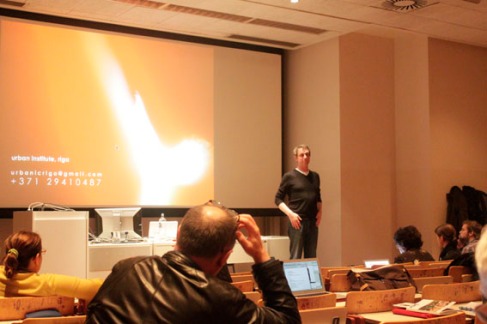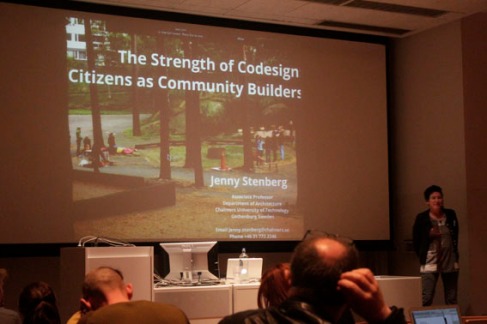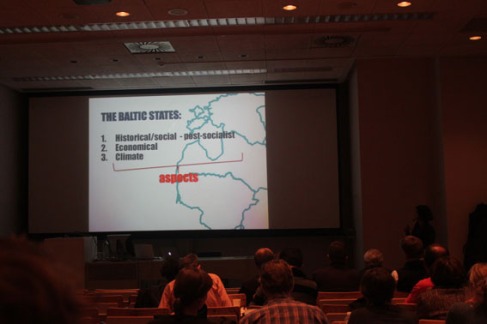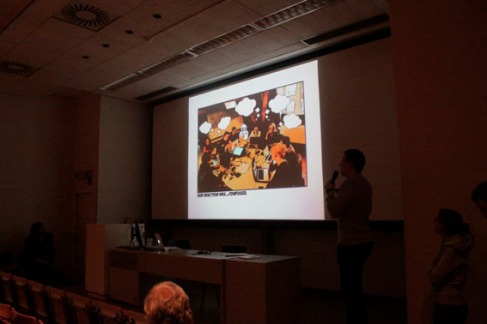ASPIS Conference Gent(BE)_Live Reporting: Day 01(PM)
End of day one, here is a short summary of this afternoon presentations.
Part 1: Designing Public Open Spaces with Public Participation
Jonas Buechel: The ‘Community Development Training Program’ in Latvia
Jonas has started the afternoon session by questioning the value of public participation – are people asking for participation or is the state imposing this idea? In order for there to be participation, activation, stimulation and provocation are needed. Change management is needed for effective participation, through education tools and community workers to form a collaborative idea about space. Educated community workers to facilitate participation in a constructive way. “…community work promotes the process of life.” The training programme will educate these community workers to generate collaboration, cooperation, support civic awareness and participation. Possible outcomes include the formation of strong and self-reliant communities.
Jenny Stenberg: The Strength of Co-design: Citizens as Community Builders
Through a specific project in the suburbs of Goethenburg, Jenny has described the participation process in for urban design. The aim of the project is to form the links between education, outreach and research. A number of techniques were successfully used: an ‘idea party’, workshops, discussions, exhibitions and a ‘test party’ for the initial designs. The idea of social tenure is key – everyone has the right to propose ideas and information during the process. If everyone is involved citizens can become community builders.
Caroline Claus and Bram: Download Lomap and let the world know what you think of your neighbourhood or city!
Caroline Claus and Bram are working on two open source, itc based tools to map one’s neighbourhood, focusing on the youth. The project is about taking a subjective lomographic photo to show the rest of the world how you feel about an area. The photos are uploaded online so it is possible for everyone see all the different mappings. The emotional and human experience gives a different angle, providing valuable information for urbanists, architects, etc… to get to know an area on a human level. Map your own neighbourhood: www.lomap.be
Nele Vanhooren: Citadelpark, a participation track seen from the perspective of the Municipality
The project is the regeneration of the Citadelpark in Gent. The park has lots of potential but also lots of problems created by its form and location. Many different buildings and functions, location between the main train station and the city centre all means a huge number of different stakeholders. Objectives for the regeneration of the park were established through meetings with the stakeholders. Participation and communication were an integral part of the project organisation. Long-term and short-term goals were agreed, these short-term goals have been implemented to show the community that progress is being made, building trust.
Part 2: Sustainability and climate in public open spaces
Margarita Karavasili: Towards Sustainable Cities: Improving urban environment through open spaces’ bioclimatic interventions
Traditionally, decisions and designs were based on economics, form and functions. Because of this, our environment has suffered greatly. It is necessary to change the way we have been living and working in recent years – public participation is necessary for sustainability. Public space today is at an interesting junction, fighting privatization and commercialization. However using these public spaces can help sustainability, upgrading open spaces to provide micro-climates and reduce the heat island effect. Physical properties affect the social characteristic of public open spaces and can also be used in this way to contribute to sustainability.
Jekaterina Balicka: Use of public space in Baltic countries and climate aspects
A presentation about the multifunctional seasonal use of different public spaces in the Baltic countries. During the summer every open space can become a public space, in winter, public spaces are often used for storage, of snow, unused benches etc. Some examples of temporary activities throughout the year in one space, demonstrates the importance and significance these events can have. A design for public space that functions throughout the whole year should be simple, inviting and universal.
International Master of Architecture Students I: ROJM EXtended, a design studio report
Teams of international students working on a design project focusing on the design of public space, within the context of a youth centre and masterplan in the city of Mechelen. The many stakeholders on the site with different requirements will be the challenge for our design, how to achieve social sustainability. Working in collaboration with the local residents, ROJM youth centre users and the city council we will try to achieve a new inclusive programme that can provide new possibilities for all of these stakeholders. Based in the city of Mechelen in West-Flanders, the site comprises the new holocaust Museum, an old monastery that will be converted to a library, housing, and the youth centre which caters for 90% youth of Moroccan and other minority backgrounds. The programme of the project is the task of designing this youth centre and the public spaces that connects all of the different functions on the site. It is not just the issue of ‘green’ to create a sustainable public space but also accommodating the different expectations, whether cultural, religious or social, of the individuals.
Discussion of Reflections on Day 1:
– Open spaces create possibilities, allow for activities to happen.
– Connectivity – we must stop thinking about public and private, all open spaces can interact.
– There are perhaps two ways of thinking emerging, the ‘other’ space where people are doing something different from at home (social ideology of heterotopias), connecting of public and private may only work on an ecological sustainability level.
– Porosity – public and private space in common use, continuity – common in southern Mediterranean European states, this is maybe different in Baltic States.
– Public vs. private: global discussion on urban design, LOVE should be important, everyone wants to be loved, have a sense of belonging. People give and take from the public realm in transition between the two.
Some photos:











